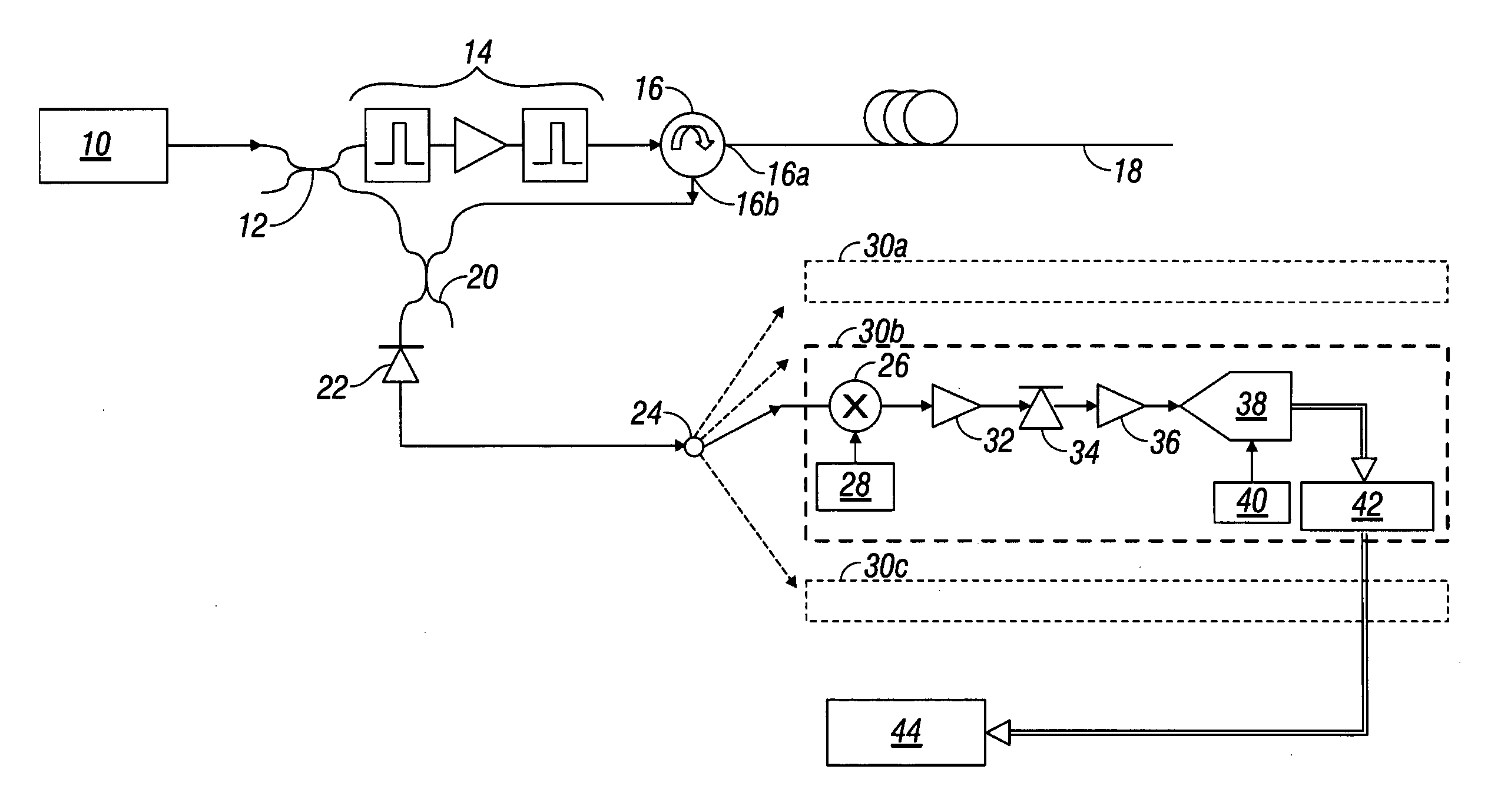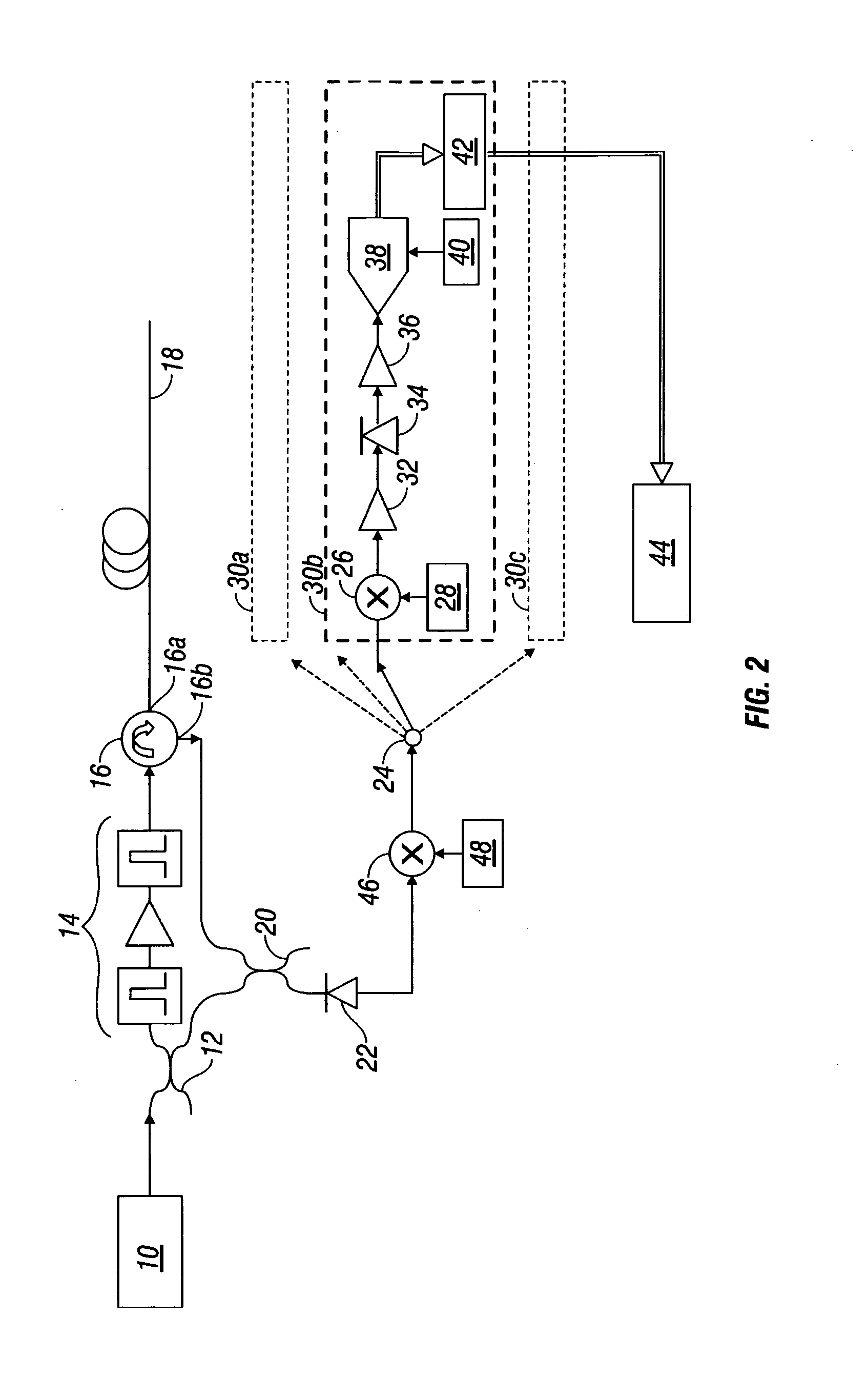Measuring brillouin backscatter from an optical fibre using channelisation
a technology of optical fibre and backscatter, which is applied in the direction of heat measurement, instrumentation, testing of fibre optic/optical waveguide devices, etc., can solve the problems of large bandwidth degrading performance, slow data acquisition time, and long process, and achieve accurate measurement and rapid measurement. , the effect of high performan
- Summary
- Abstract
- Description
- Claims
- Application Information
AI Technical Summary
Benefits of technology
Problems solved by technology
Method used
Image
Examples
first example embodiment
[0028]FIG. 1 shows a schematic representation of apparatus for implementing a measurement method according to an embodiment of the present invention. This example uses electrical detection in the parallel measurement channels.
[0029]An optical source 10 operable to generate narrow-band coherent light (such as a laser) produces an output beam at a frequency f0. The beam is directed into a beam splitter 12 (such as a 3 dB fibre splitter) that divides the output beam into a first part for launching into a deployed optical fibre 18, and a second part to be mixed with light received back from the optical fibre 18. The first part passes through a pulse forming unit 14 that produces optical probe pulses of a desired repetition frequency, pulse duration, and power, suitable for probing of the deployed optical fibre 18 to obtain Brillouin backscatter. In this example the pulse forming unit 14 comprises two pulse generators / gates with an amplifier between. However, any required combination of ...
second example embodiment
[0043]FIG. 2 shows a schematic representation of a second example of apparatus according to an embodiment of the present invention. This apparatus is substantially the same as that shown in FIG. 1, in that received backscattered light is frequency mixed with other light in an optical detector to produce an electrical difference frequency signal that is then split between a plurality of detection channels distinguished by frequency range, in which the signal is detected and digitized for signal processing.
[0044]However, the apparatus of FIG. 2 further includes a secondary electrical signal mixer 46 disposed between the optical detector 22 and the electrical signal splitter 24. Connected to the secondary electrical signal mixer 46 is a secondary electrical local oscillator 48 operable to generate a secondary electrical signal at a constant frequency fC. The secondary electrical signal mixer 46 receives the primary electrical signal at ΔF(t) from the optical detector. The signal underg...
third example embodiment
[0045]FIG. 3 shows a schematic representation of apparatus according to a further embodiment of the invention.
[0046]The embodiments of FIGS. 1 and 2 utilize an arrangement in which the received backscattered light is converted to an electrical signal by difference frequency mixing before detection. In contrast, FIG. 3 shows an apparatus in which the backscatter is retained in the optical domain for detection.
[0047]As in FIGS. 1 and 2, an optical source 10 generates coherent light at a frequency f0 which is passed through a pulse forming unit 14 that produces probe pulses which are launched into a deployed optical fibre 18 via a first port 16a of an optical circulator 16. However, the returned Brillouin backscatter is not then mixed with another optical signal in an optical detector as in FIGS. 1 and 2. Instead, the second port 16b of the optical circulator 16 is arranged to deliver the backscattered light received from the optical fibre 18 along an optical beam path (defined by an o...
PUM
| Property | Measurement | Unit |
|---|---|---|
| difference frequency ΔF( | aaaaa | aaaaa |
| frequency ΔF2 | aaaaa | aaaaa |
| difference frequency ΔF(t | aaaaa | aaaaa |
Abstract
Description
Claims
Application Information
 Login to View More
Login to View More - R&D
- Intellectual Property
- Life Sciences
- Materials
- Tech Scout
- Unparalleled Data Quality
- Higher Quality Content
- 60% Fewer Hallucinations
Browse by: Latest US Patents, China's latest patents, Technical Efficacy Thesaurus, Application Domain, Technology Topic, Popular Technical Reports.
© 2025 PatSnap. All rights reserved.Legal|Privacy policy|Modern Slavery Act Transparency Statement|Sitemap|About US| Contact US: help@patsnap.com



